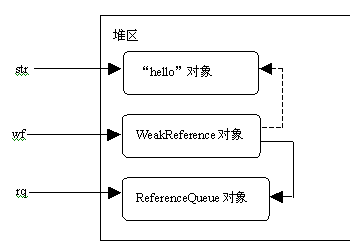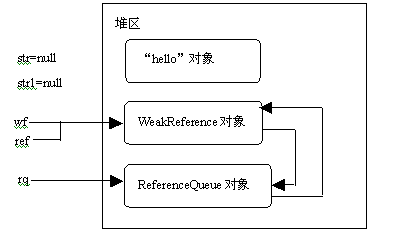Java 中的引用类型
Java 中的引用类型?
除了8大基本数据类型(不包括void),其他都是引用类型.
可能面试官就是问的上面这个,但是如果你能补充下去,这会是一个很好的展现机会!
java中的引用类型分为4种:强,软,弱,虚!这中分类与GC有关,如果你对GC有一些了解的话,可以继续谈谈,如果不了解GC的话,建议适可而止..
1.对象的强、软、弱和虚引用
在JDK 1.2以前的版本中,若一个对象不被任何变量引用,那么程序就无法再使用这个对象。也就是说,只有对象处于可触及(reachable)状态,程序才能使用它。从JDK 1.2版本开始,把对象的引用分为4种级别,从而使程序能更加灵活地控制对象的生命周期。这4种级别由高到低依次为:强引用、软引用、弱引用和虚引用。
1)强引用(StrongReference)
强引用是使用最普遍的引用。如果一个对象具有强引用,那垃圾回收器绝不会回收它。当内存空间不足,Java虚拟机宁愿抛出OutOfMemoryError错误,使程序异常终止,也不会靠随意回收具有强引用的对象来解决内存不足的问题。
2)软引用(SoftReference)
如果一个对象只具有软引用,则内存空间足够,垃圾回收器就不会回收它;如果内存空间不足了,就会回收这些对象的内存。只要垃圾回收器没有回收它,该对象就可以被程序使用。软引用可用来实现内存敏感的高速缓存
软引用可以和一个引用队列(ReferenceQueue)联合使用,如果软引用所引用的对象被垃圾回收器回收,Java虚拟机就会把这个软引用加入到与之关联的引用队列中。
3) 弱引用(WeakReference)
弱引用与软引用的区别在于:弱引用的对象拥有更短暂的生命周期。在垃圾回收器线程扫描它所管辖的内存区域的过程中,一旦发现了只具有弱引用的对象,不管当前内存空间足够与否,都会回收它的内存。不过,由于垃圾回收器是一个优先级很低的线程,因此不一定会很快发现那些只具有弱引用的对象。
弱引用可以和一个引用队列(ReferenceQueue)联合使用,如果弱引用所引用的对象被垃圾回收,Java虚拟机就会把这个弱引用加入到与之关联的引用队列中。
String str = new String("hello"); //--1--
ReferenceQueue<String> rq = new ReferenceQueue<String>(); //--2--
WeakReference<String> wf = new WeakReference<String>(str, rq); //--3--
str=null; //--4--取消"hello"对象的强引用
String str1=wf.get(); //--5--假如"hello"对象没有被回收,str1引用"hello"对象
//假如"hello"对象没有被回收,rq.poll()返回
null
Reference<? extends String> ref=rq.poll(); //--6--
带实线的箭头表示强引用,带虚线的箭头表示弱引用。从图中可以看出,此时"hello"对象被str强引用,并且被一个WeakReference对象弱引用,因此"hello"对象不会被垃圾回收。
在以下程序代码中,把引用"hello"对象的str变量置为null,然后再通过WeakReference弱引用的get()方法获得"hello"对象的引用:
执行完以上第④行后,内存中引用与对象的关系如图11-11所示,此 时"hello"对象仅仅具有弱引用,因此它有可能被垃圾回收。假如它还没有被垃圾回收,那么接下来在第⑤行执行wf.get()方法会返回 "hello"对象的引用,并且使得这个对象被str1强引用。再接下来在第⑥行执行rq.poll()方法会返回null,因为此时引用队列中没有任何 引用。ReferenceQueue的poll()方法用于返回队列中的引用,如果没有则返回null。
在以下程序代码中,执行完第④行后,"hello"对象仅仅具有弱引用。接下来两次调用System.gc()方法,催促垃圾回收器工作,从而提高 "hello"对象被回收的可能性。假如"hello"对象被回收,那么WeakReference对象的引用被加入到ReferenceQueue中, 接下来wf.get()方法返回null,并且rq.poll()方法返回WeakReference对象的引用。图11-12显示了执行完第⑧行后内存 中引用与对象的关系。
String str = new String("hello"); //①
ReferenceQueue<String> rq = new ReferenceQueue<String>(); //②
WeakReference<String> wf = new WeakReference<String>(str, rq); //③
str=null; //④
//两次催促垃圾回收器工作,提高"hello"对象被回收的可能性
System.gc(); //⑤
System.gc(); //⑥
String str1=wf.get(); //⑦ 假如"hello"对象被回收,str1为null
Reference<? extends String> ref=rq.poll(); //⑧
在以下例程11-15的References类中,依次创建了10个软引用、10个弱引用和10个虚引用,它们各自引用一个Grocery对象。从程序运 行时的打印结果可以看出,虚引用形同虚设,它所引用的对象随时可能被垃圾回收,具有弱引用的对象拥有稍微长的生命周期,当垃圾回收器执行回收操作时,有可 能被垃圾回收,具有软引用的对象拥有较长的生命周期,但在Java虚拟机认为内存不足的情况下,也会被垃圾回收。
import java.lang.ref.*;
import java.util.*;
class Grocery{
private static final int SIZE = 10000;
//属性d使得每个Grocery对象占用较多内存,有80K左右
private double[] d = new double[SIZE];
private String id;
public Grocery(String id) { this.id = id; }
public String toString() { return id; }
public void finalize() {
System.out.println("Finalizing " + id);
}
}
public class References {
private static ReferenceQueue<Grocery> rq = new ReferenceQueue<Grocery>();
public static void checkQueue() {
Reference<? extends Grocery> inq = rq.poll();
//从队列中取出一个引用
if(inq != null)
System.out.println("In queue: "+inq+" : "+inq.get());
}
public static void main(String[] args) {
final int size=10;
//创建10个Grocery对象以及10个软引用
Set<SoftReference<Grocery>> sa = new HashSet<SoftReference<Grocery>>();
for(int i = 0; i < size; i++) {
SoftReference<Grocery> ref=
new SoftReference<Grocery>(new Grocery("Soft " + i), rq);
System.out.println("Just created: " +ref.get());
sa.add(ref);
}
System.gc();
checkQueue();
//创建10个Grocery对象以及10个弱引用
Set<WeakReference<Grocery>> wa = new HashSet<WeakReference<Grocery>>();
for(int i = 0; i < size; i++) {
WeakReference<Grocery> ref=
new WeakReference<Grocery>(new Grocery("Weak " + i), rq);
System.out.println("Just created: " +ref.get());
wa.add(ref);
}
System.gc();
checkQueue();
//创建10个Grocery对象以及10个虚引用
Set<PhantomReference<Grocery>> pa = new HashSet<PhantomReference<Grocery>>();
for(int i = 0; i < size; i++) {
PhantomReference<Grocery>ref =
new PhantomReference<Grocery>(new Grocery("Phantom " + i), rq);
System.out.println("Just created: " +ref.get());
pa.add(ref);
}
System.gc();
checkQueue();
}
}
在Java集合中有一种特殊的Map类型:WeakHashMap, 在这种Map中存放了键对象的弱引用,当一个键对象被垃圾回收,那么相应的值对象的引用会从Map中删除。WeakHashMap能够节约存储空间,可用 来缓存那些非必须存在的数据。关于Map接口的一般用法,可参见本书第15章的15.4节(Map)。
以下例程11-16的MapCache类的main()方法创建了一个WeakHashMap对象,它存放了一组Key对象的弱引用,此外main()方法还创建了一个数组对象,它存放了部分Key对象的强引用。
//例程11-16 MapCache.java
import java.util.*;
import java.lang.ref.*;
class Key {
String id;
public Key(String id) { this.id = id; }
public String toString() { return id; }
public int hashCode() {
return id.hashCode();
}
public boolean equals(Object r) {
return (r instanceof Key)
&& id.equals(((Key)r).id);
}
public void finalize() {
System.out.println("Finalizing Key "+ id);
}
}
class Value {
String id;
public Value(String id) { this.id = id; }
public String toString() { return id; }
public void finalize() {
System.out.println("Finalizing Value "+id);
}
}
public class MapCache {
public static void main(String[] args) throws Exception{
int size = 1000;
// 或者从命令行获得size的大小
if(args.length > 0)size = Integer.parseInt(args[0]);
Key[] keys = new Key[size]; //存放键对象的强引用
WeakHashMap<Key,Value> whm = new WeakHashMap<Key,Value>();
for(int i = 0; i < size; i++) {
Key k = new Key(Integer.toString(i));
Value v = new Value(Integer.toString(i));
if(i % 3 == 0) keys[i] = k; //使Key对象持有强引用
whm.put(k, v); //使Key对象持有弱引用
}
//催促垃圾回收器工作
System.gc();
//把CPU让给垃圾回收器线程
Thread.sleep(8000);
}
}
/*以上程序的部分打印结果如下:
Finalizing Key 998
Finalizing Key 997
Finalizing Key 995
Finalizing Key 994
Finalizing Key 992
Finalizing Key 991
Finalizing Key 989
Finalizing Key 988
Finalizing Key 986
Finalizing Key 985
Finalizing Key 983*/
从打印结果可以看出,当执行System.gc()方法后,垃圾回收器只会回收那些仅仅持有弱引用的Key对象。id可以被3整数的Key对象持有强引用,因此不会被回收。
感谢原作者:
原文链接


